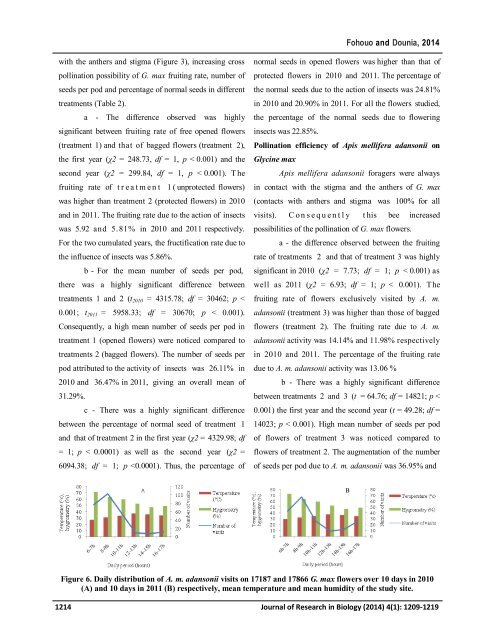Foraging and pollination behavior of Apis mellifera adansonii Latreille (Hymenoptera: Apidae) on Glycine max L. (Fabaceae) flowers at Maroua
To assess the impact of Apis mellifera adansonii on pod and seed yields of Glycine max, its foraging and pollinating activities were studied in Maroua, during the two season seasons (August-September 2010 and 2011). Observations were made on 51 to 17866 flowers per treatment. Treatment 1 represented by free flowers; treatment 2 bagged flowers and treatment 3 flowers visited only by A. m. adansonii. In addition, all flower visitors were recorded. The abundance of bee, duration of visits, impact of activity of A. m. adansonii on fruiting percentage, the influence of this bee on formation of pods, number of seeds in each pods and average of normal seeds (well developed) were recorded. Individuals from 28 species of insects were recorded on the flowers of G. max, after two years of observations. Apis mellifera adansonii with 23.18% of 954 visits was the most frequent, followed by Polyrachis sp. 1 (14.77%), Macronomia vulpina (14.22%), Lipotriches collaris (11.07%). This honey bee intensely and exclusively foraged for nectar. The mean foraging speed was 12.56 ± 5.79 flowers per minute. Flowers visited by insects had higher fruiting rate compared with the others while those bagged had the lowest. Apis mellifera adansonii foraging resulted to a significant increment in fruiting rate by 14.14 and 11.98%, as well as the number of seeds per pod by 36.95 and 35.65%, and the percentage of normal seeds by 32.61 and 29.26% respectively in 2010 and 2011. The installation of A. m. adansonii colonies in G. max plantations is recommended to improve pod and seeds production of this species.
To assess the impact of Apis mellifera adansonii on pod and seed yields of Glycine max, its foraging and pollinating activities were studied in Maroua, during the two season seasons (August-September 2010 and 2011). Observations were made on 51 to 17866 flowers per treatment. Treatment 1 represented by free flowers; treatment 2 bagged flowers and treatment 3 flowers visited only by A. m. adansonii. In addition, all flower visitors were recorded. The abundance of bee, duration of visits, impact of activity of A. m. adansonii on fruiting percentage, the influence of this bee on formation of pods, number of seeds in each pods and average of normal seeds (well developed) were recorded. Individuals from 28 species of insects were recorded on the flowers of G. max, after two years of observations. Apis mellifera adansonii with 23.18% of 954 visits was the most frequent, followed by Polyrachis sp. 1 (14.77%), Macronomia vulpina (14.22%), Lipotriches collaris (11.07%). This honey bee intensely and exclusively foraged for nectar. The mean foraging speed was 12.56 ± 5.79 flowers per minute. Flowers visited by insects had higher fruiting rate compared with the others while those bagged had the lowest. Apis mellifera adansonii foraging resulted to a significant increment in fruiting rate by 14.14 and 11.98%, as well as the number of seeds per pod by 36.95 and 35.65%, and the percentage of normal seeds by 32.61 and 29.26% respectively in 2010 and 2011. The installation of A. m. adansonii colonies in G. max plantations is recommended to improve pod and seeds production of this species.
Create successful ePaper yourself
Turn your PDF publications into a flip-book with our unique Google optimized e-Paper software.
Fohouo <str<strong>on</strong>g>and</str<strong>on</strong>g> Dounia, 2014<br />
with the anthers <str<strong>on</strong>g>and</str<strong>on</strong>g> stigma (Figure 3), increasing cross<br />
<str<strong>on</strong>g>pollin<strong>at</strong>i<strong>on</strong></str<strong>on</strong>g> possibility <str<strong>on</strong>g>of</str<strong>on</strong>g> G. <strong>max</strong> fruiting r<strong>at</strong>e, number <str<strong>on</strong>g>of</str<strong>on</strong>g><br />
seeds per pod <str<strong>on</strong>g>and</str<strong>on</strong>g> percentage <str<strong>on</strong>g>of</str<strong>on</strong>g> normal seeds in different<br />
tre<strong>at</strong>ments (Table 2).<br />
a - The difference observed was highly<br />
significant between fruiting r<strong>at</strong>e <str<strong>on</strong>g>of</str<strong>on</strong>g> free opened <strong>flowers</strong><br />
(tre<strong>at</strong>ment 1) <str<strong>on</strong>g>and</str<strong>on</strong>g> th<strong>at</strong> <str<strong>on</strong>g>of</str<strong>on</strong>g> bagged <strong>flowers</strong> (tre<strong>at</strong>ment 2),<br />
the first year (χ2 = 248.73, df = 1, p < 0.001) <str<strong>on</strong>g>and</str<strong>on</strong>g> the<br />
sec<strong>on</strong>d year (χ2 = 299.84, df = 1, p < 0.001). T he<br />
fruiting r<strong>at</strong>e <str<strong>on</strong>g>of</str<strong>on</strong>g> t r e a t m e n t 1 ( unprotected <strong>flowers</strong>)<br />
was higher than tre<strong>at</strong>ment 2 (protected <strong>flowers</strong>) in 2010<br />
<str<strong>on</strong>g>and</str<strong>on</strong>g> in 2011. The fruiting r<strong>at</strong>e due to the acti<strong>on</strong> <str<strong>on</strong>g>of</str<strong>on</strong>g> insects<br />
was 5.92 <str<strong>on</strong>g>and</str<strong>on</strong>g> 5.81% in 2010 <str<strong>on</strong>g>and</str<strong>on</strong>g> 2011 respectively.<br />
For the two cumul<strong>at</strong>ed years, the fructific<strong>at</strong>i<strong>on</strong> r<strong>at</strong>e due to<br />
the influence <str<strong>on</strong>g>of</str<strong>on</strong>g> insects was 5.86%.<br />
b - For the mean number <str<strong>on</strong>g>of</str<strong>on</strong>g> seeds per pod,<br />
there was a highly significant difference between<br />
tre<strong>at</strong>ments 1 <str<strong>on</strong>g>and</str<strong>on</strong>g> 2 (t 2010 = 4315.78; df = 30462; p <<br />
0.001; t 2011 = 5958.33; df = 30670; p < 0.001).<br />
C<strong>on</strong>sequently, a high mean number <str<strong>on</strong>g>of</str<strong>on</strong>g> seeds per pod in<br />
tre<strong>at</strong>ment 1 (opened <strong>flowers</strong>) were noticed compared to<br />
tre<strong>at</strong>ments 2 (bagged <strong>flowers</strong>). The number <str<strong>on</strong>g>of</str<strong>on</strong>g> seeds per<br />
pod <strong>at</strong>tributed to the activity <str<strong>on</strong>g>of</str<strong>on</strong>g> insects was 26.11% in<br />
2010 <str<strong>on</strong>g>and</str<strong>on</strong>g> 36.47% in 2011, giving an overall mean <str<strong>on</strong>g>of</str<strong>on</strong>g><br />
31.29%.<br />
c - There was a highly significant difference<br />
between the percentage <str<strong>on</strong>g>of</str<strong>on</strong>g> normal seed <str<strong>on</strong>g>of</str<strong>on</strong>g> tre<strong>at</strong>ment 1<br />
<str<strong>on</strong>g>and</str<strong>on</strong>g> th<strong>at</strong> <str<strong>on</strong>g>of</str<strong>on</strong>g> tre<strong>at</strong>ment 2 in the first year (χ2 = 4329.98; df<br />
= 1; p < 0.0001) as well as the sec<strong>on</strong>d year (χ2 =<br />
6094.38; df = 1; p

















